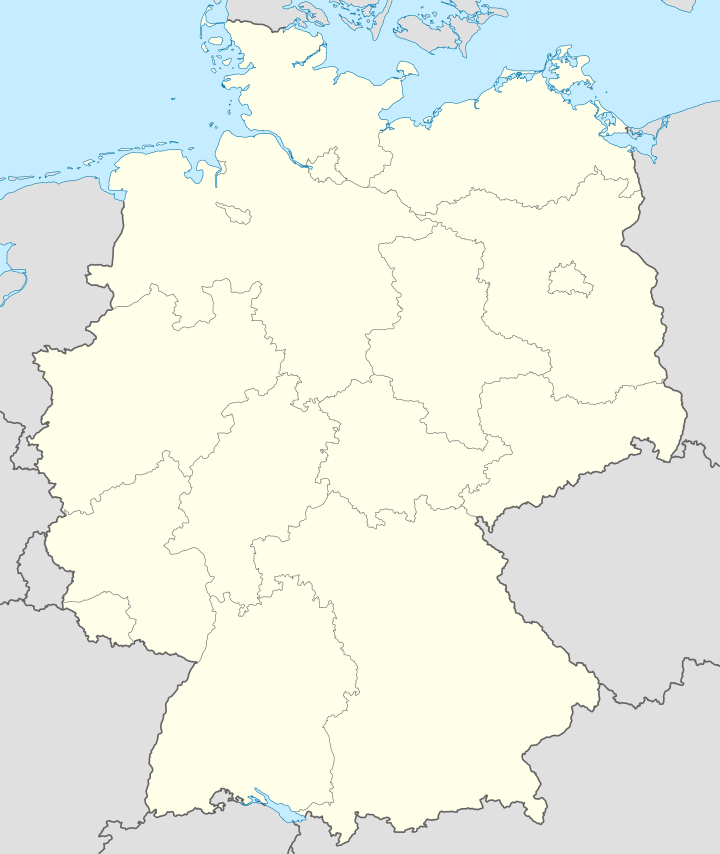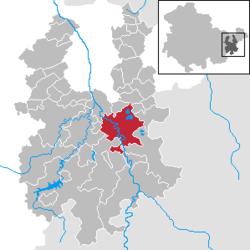Berga, Thuringia
| Berga | ||
|---|---|---|
| ||
 Berga | ||
Location of Berga within Greiz district  | ||
| Coordinates: 50°45′N 12°10′E / 50.750°N 12.167°ECoordinates: 50°45′N 12°10′E / 50.750°N 12.167°E | ||
| Country | Germany | |
| State | Thuringia | |
| District | Greiz | |
| Government | ||
| • Mayor | Stephan Büttner | |
| Area | ||
| • Total | 43.49 km2 (16.79 sq mi) | |
| Population (2013-12-31)[1] | ||
| • Total | 3,493 | |
| • Density | 80/km2 (210/sq mi) | |
| Time zone | CET/CEST (UTC+1/+2) | |
| Postal codes | 07980 | |
| Dialling codes | 036623 | |
| Vehicle registration | GRZ | |
| Website | Stadt-Berga.de | |
Berga/Elster is a town in the district of Greiz, in Thuringia, Germany. It is situated on the White Elster river, 14 km southeast of Gera.
History
Within the German Empire (1871-1918), Berga/Elster was part of the Grand Duchy of Saxe-Weimar-Eisenach.
Berga Concentration Camp
During World War II, a slave labor camp called "Berga an der Elster"[2] was operated here to dig 17 tunnels for an underground ammunition factory. Workers were supplied by Buchenwald concentration camp and from a POW camp, Stalag IX-B; the latter contravened the provisions of the Third Geneva Convention and of the Hague Treaties. Many prisoners died as a result of malnutrition, sickness (including pulmonary disease due to dust inhalation from tunnelling with explosives), and beatings,[3] including 73 American POWs.[4][5] The labor camp formed part of Germany's secret plan to transform, via hydrogenation, brown coal into usable fuel for tanks, planes, and other military machinery. However, the camp's additional purpose was Vernichtung durch Arbeit (or "extermination through labor"), and prisoners were intentionally worked to death through inhumane working and living conditions, and starvation. This secondary purpose of extermination was carried out until the war's end, when the prisoners were subjected to a forced death march to keep ahead of the advancing allied forces.[5]
Berga was run by a fanatical German national guard sergeant named Erwin Metz, who was responsible for the inhumane conditions and who gave the order to take the prisoners on the death march. When the allied forces closed in on the retreating Germans, Metz deserted his post and attempted to escape by bicycle, fearing the consequences of being captured in possession of the remaining Berga prisoners and having to answer for his war crimes. Still, he was captured days after the prisoners were liberated by American forces, and he was sentenced to death, because he had killed a US POW Pvt Morton Goldstein {Battery C/590th Field Artillery/106 US Division} on March 14, 1945. However, due to the American political climate and the American War Department's shifting priorities towards defending against the Soviets in the lead up to the Cold War, many German war criminals' sentences were commuted in exchange for intelligence that the Western allies believed to could be used against the Soviets. Metz was therefore sentenced to twenty years but was only imprisoned for nine years before being released back into Germany a free man.[5]
See also
- List of Nazi-German concentration camps
- Project Riese
- Soldiers and Slaves (2005)
References
- ↑ "Bevölkerung der Gemeinden, erfüllenden Gemeinden und Verwaltungsgemeinschaften nach Geschlecht in Thüringen". Thüringer Landesamt für Statistik (in German). 13 July 2013.
- ↑ "After 63 years, vet learns of brother's death in Nazi slave camp". CNN. 2008-11-20. Retrieved 2008-11-20.
- ↑ "New photo: Nazis dig up mass grave of U.S. soldiers". CNN. 2009-04-24. Retrieved 2009-04-24.
Berga an der Elster was a slave labor camp where 350 U.S. soldiers were beaten, starved, and forced to work in tunnels for the German government. The soldiers were singled out for "looking like Jews", "sounding like Jews", having names that "sounded Jewish", or having been dubbed as undesirables, according to survivors. More than 100 soldiers perished at the camp or on a forced death march.
- ↑ Reich, Walter (2005-05-01). "Yanks in the Holocaust". The New York Times. Retrieved 2010-04-26.
- ↑ 5.0 5.1 5.2 Hitler's G.I. Death Camp (television documentary). National Geographic. 2012.
Additional reading
- Flint Whitlock (March 2005). Given Up For Dead - American GIs in the Nazi Concentration Camp at Berga. Basic Books. ISBN 0-8133-4288-0.
-

An American soldier questions a civilian from a nearby town in the Berga-Elster concentration camp.
External links
- "About Berga". PBS.org.
- "Acevedo: WW II vet held in Nazi slave camp breaks silence". CNN.com. 2008.
- "City Website Berga/Elster". stadt-berga.de.
- "Description of KZ Berga". Wild Bill Garnere forums.
- "District Greiz". landkreis-greiz.de.
- "Pictures: Survivor of Berga 1945". National Geographic Channel.
- "The Lost Soldiers of Stalag IX-B". New York Times Traces.
- "'You don't forget': Medic's Holocaust diary tells story of hell". CNN. October 28, 2010.
